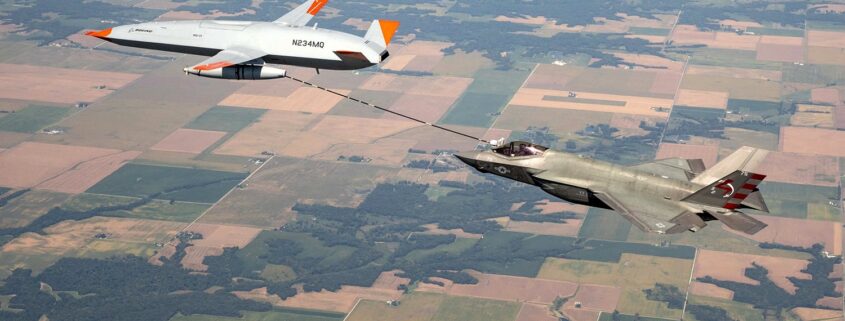Boeing’s MQ-25 Stingray drone refuels F-35C in mid-air for the first time
Boeing’s MQ-25 T1 Stingray drone has successfully refueled a U.S. Navy F-35C Lightning II fighter jet in mid-air for the first time, once again demonstrating the aircraft’s ability to achieve its primary aerial refueling mission.
This was the third refueling mission for the Boeing-owned test asset in just over three months, advancing the test program for the Navy’s first operational carrier-based unmanned aircraft. Previously, T1 refueled a F/A-18 Super Hornet fighter in June and an E-2D Hawkeye command and control aircraft in August – to show the drone can refuel a wide variety of carrier-based aircraft.
During the three-hour flight, a Navy F-35C test pilot Evaluation Squadron Two Three (VX-23) conducted a successful wake survey behind T1 to ensure performance and stability before making contact with T1’s aerial refueling drogue and receiving fuel. The test asset flew at 225 knots calibrated airspeed (KCAS) and an altitude of 10,000 feet. From the ground control station, an air vehicle operator then initiated the fuel transfer from T1’s aerial refueling store to the F-35C.
The test flight with an Aerial Refueling Store (ARS) under the left-wing took place in early December 2020. With this ARS, F/A-18s are already being refueled air-to-air with existing manned aircraft. According to Boeing, the MQ-25 will be used to refuel F/A-18 Super Hornets, EA-18G Growlers, and Lockheed Martin F-35Cs in the air, among others.
“Every test flight with another Type/Model/Series aircraft gets us one step closer to rapidly delivering a fully mission-capable MQ-25 to the fleet,” said Capt. Chad Reed, the Navy’s Unmanned Carrier Aviation program manager. “Stingray’s unmatched refueling capability is going to increase the Navy’s power projection and provide operational flexibility to the Carrier Strike Group commanders.“
Following this flight, the MQ-25 T1 Stingray drone will enter into a modification period to integrate the deck handling system in preparation for a shipboard demonstration this winter. T1 has conducted 36 flights to date, gathering data on everything from aircraft performance to propulsion dynamics to structural loads and flutter testing for strength and stability.
MQ-25 is benefitting from the two years of early flight test data, which has been integrated into its digital models to strengthen the digital thread that connects aircraft design to production to test operations and sustainment. Boeing is currently manufacturing the first two MQ-25 test aircraft.
BY: AMIT MALEWAR




